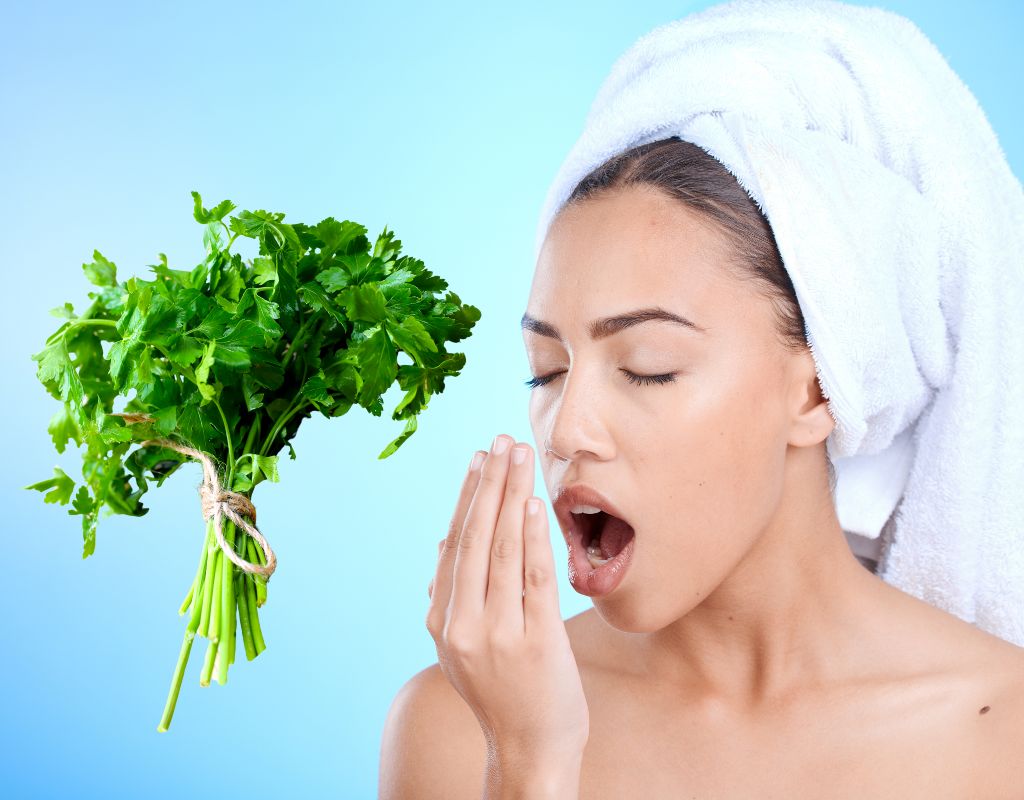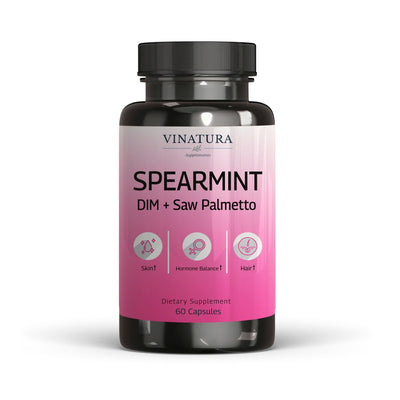
Does Parsley Help with Bad Breath and Body Odor?
Did you know that one in two adults has experienced bad breath without realizing it? According to the American Dental Association, nearly 50% of the population has dealt with this issue, which may seem minor but can significantly impact confidence, communication, and quality of life.
Bad breath, or halitosis, often stems from anaerobic bacteria breaking down food particles in the mouth, producing volatile sulfur compounds (VSCs) that cause unpleasant odors.
While products like breath mints or mouthwash only mask the smell temporarily, many people are turning to natural, safe solutions that work from within. One standout option is parsley, a common kitchen herb known as a traditional remedy for freshening breath.
Parsley is also celebrated as a “natural internal deodorizer,” potentially neutralizing body odor for a lasting sense of freshness.
This article will explore whether parsley truly helps with bad breath, how it works, the best ways to use it safely, and key precautions to ensure you get the most out of this familiar herb’s deodorizing benefits.
Before exploring further, please read the disclaimer located at the end of this webpage.
Key Takeaways
- Bad breath often comes from sulfur compounds in the mouth.
- Parsley may help neutralize odors with chlorophyll and oils.
- Use fresh parsley, tea, or smoothies for daily support.
- Good oral hygiene is still essential.
- Use parsley moderately; some people should consult a doctor.
What Causes Bad Breath?

Bad breath is a common issue that can make people feel self-conscious during daily interactions. To understand why it happens and how to address it effectively, we first need to identify its main bad breath causes.
From food trapped in the mouth to underlying medical conditions, halitosis can arise from various factors, and tackling the root cause is essential for long-lasting fresh breath [2].
The mouth - source of most odor: Most cases of bad breath, about 90%, originate in the mouth. A primary culprit is food debris stuck between teeth or on the tongue’s surface. When not properly cleaned, these particles are broken down by bacteria, releasing VSCs like hydrogen sulfide and methyl mercaptan, which create foul odors [13].
Bacteria thrive on the tongue: The back of your tongue is like prime real estate for odor-causing bacteria. Anaerobic species such as Porphyromonas gingivalis and Fusobacterium nucleatum thrive here, where they break down food particles and release foul-smelling compounds [4].
A dry mouth only makes things worse. Saliva isn’t just for moisture, it plays a key role in rinsing away bacteria and leftover food. But when saliva runs low, whether from certain medications, mouth breathing, smoking, or dehydration, those bacteria can flourish unchecked, leading to noticeably worse breath [3].
Diet plays a significant role in bad breath: Strong-smelling foods like garlic and onions leave lingering odors, not just in the mouth but also through the breath, as compounds like allyl methyl sulfide are absorbed into the bloodstream and exhaled through the lungs [5].
High-protein diets provide fuel for bacteria to produce VSCs, while sugary foods encourage acid-producing bacteria, creating an environment ripe for odor-causing compounds [2].
Even low-carb diets can lead to “ketone breath,” with a fruity or acetone-like smell, as the body burns fat for energy [4]. Gut health can also contribute, with digestive issues like gastroesophageal reflux disease (GERD) occasionally causing odors, though this is less common [10].
Temporary vs. chronic halitosis: Bad breath can be temporary or chronic, depending on its cause. Temporary bad breath, often called “morning breath,” occurs when saliva flow decreases during sleep, allowing bacteria to build up overnight.
This usually resolves after eating or brushing [4]. Similarly, odors from foods like garlic are short-lived [5]. Bad breath, affecting 10-30% of the population, persists throughout the day and may signal issues like persistent bacterial buildup, gum disease, or systemic conditions such as liver or kidney failure, or diabetic ketoacidosis, where compounds like ammonia or acetone are exhaled [13].
Rare metabolic disorders, like trimethylaminuria (causing a fishy smell), can also be culprits [5].
When the cause is beyond the mouth: In 5-10% of cases, bad breath originates outside the mouth. Odor-causing compounds like dimethyl sulfide (DMS) can be absorbed into the blood from the stomach, intestines, or liver and released through the lungs [13].
Respiratory infections, such as sinusitis or bronchitis, may also contribute [4]. Certain medications can cause dry mouth or produce odorous compounds in the body, complicating the issue [3].
Why masking isn’t enough: Simply masking breath with gum or mouthwash provides only temporary relief. These solutions don’t eliminate the root causes.
For lasting fresh breath, it’s essential to address the underlying bad breath causes through proper oral hygiene, dietary changes, and treatment of any contributing health issues [2]. This sets the foundation for exploring natural remedies for halitosis, such as the potential benefits of parsley.
Is Parsley Good for Bad Breath?

Yes, parsley can help freshen breath and reduce body odor naturally. Its chlorophyll and essential oils neutralize sulfur compounds and support a cleaner, fresher internal environment.
Parsley has long been recognized as a natural breath freshener, thanks to key compounds like chlorophyll, myristicin, and apiol. These substances help neutralize volatile sulfur compounds (VSCs), the byproducts of anaerobic bacteria breaking down food debris and saliva in the mouth [1,2].
The herb’s essential oils also may help reduce bacterial activity linked to odor, though parsley is not a substitute for proper oral care, a known contributor to oral malodor [2].
Additionally, polyphenols in parsley help balance mouth pH, limiting plaque buildup and supporting overall oral health [7]. The deodorizing effects go beyond the mouth: chlorophyll also binds to odor-causing sulfur compounds like hydrogen sulfide and methyl mercaptan, which are excreted through both breath and sweat [1].
Historically, parsley has been used in Mediterranean cultures to reduce food odors after meals—most notably garlic and onions by chewing fresh leaves [12]. Traditional practices also note its ability to soothe the mouth, reduce mild inflammation, and create a less favorable environment for bacteria [4].
How Parsley May Help Neutralize Odors

Beyond its traditional use, parsley’s effectiveness lies in its diverse phytochemical profile. It contains not only chlorophyll and essential oils, but also flavonoids like luteolin and apigenin, and compounds such as catechin, which contribute to its antioxidant and antibacterial activity [6].
Notably, catechin may inhibit bacterial enzyme activity, further disrupting VSC production at the biochemical level [2]. Parsley also complements digestion-related odor control especially after sulfur-rich foods by helping neutralize lingering smells, a practice still common in culinary traditions [1].
A key mechanism often overlooked is parsley’s ability to stimulate saliva production. Chewing fresh parsley not only refreshes the palate but also increases saliva flow, which naturally rinses away bacteria, food particles, and odor compounds.
This helps maintain an environment less favorable to odor-causing anaerobic bacteria [10]. Being a water-rich herb, parsley also supports oral hydration, countering dry mouth—a frequent contributor to persistent bad breath [2].
Finally, parsley may promote a more balanced oral microbiome and reduce minor inflammation, offering further support for breath freshness and comfort [7].
How to Use Parsley for Bad Breath
Now that we understand how parsley neutralizes odors, let’s look at practical ways to incorporate it into your daily routine to freshen breath and reduce body odor. These simple, effective methods help you make the most of parsley’s natural deodorizing benefits.
Chew Fresh Parsley
Chewing fresh parsley after meals is one of the easiest approaches. This not only freshens the mouth but also boosts saliva production, which clears away odor-causing bacteria.
For best results, chew 2–3 sprigs for 1–2 minutes after eating, especially after garlic, onions, or other pungent foods. Do this 2–3 times daily to keep breath fresh (Ajmera et al., 2019).
Parsley Tea or Mouth Rinse

If chewing raw parsley isn’t your preference, parsley tea offers a gentle alternative. Rinse 1/4 cup of fresh parsley leaves, chop them finely, and steep in 1 cup of boiling water for 5–10 minutes.
Strain, cool slightly, and sip as a refreshing tea or use as a mouth rinse. Drink or rinse once daily, ideally in the morning or after a meal, to neutralize odors and combat dry mouth (Nir Sterer & Rosenberg, 2020).
Parsley Smoothies
For smoothie lovers, parsley juice is a convenient way to ingest its deodorizing compounds. Blend 1/2 cup of fresh parsley with fruits like apples, bananas, or berries, and a splash of lemon juice for flavor.
This mix freshens breath and provides antioxidants. Drink a parsley smoothie 3–4 times a week in the morning for optimal absorption.
Pairing with Peppermint or Lemon
Combining parsley with natural breath fresheners like peppermint or lemon enhances its effects. Chew parsley with a few peppermint leaves or add lemon juice to your tea or smoothie.
These pairings reduce sulfur compounds and leave a pleasant taste. Use this method 1–2 times daily, such as after lunch or dinner, for a fresher mouth [2].
Parsley Supplements for On-the-Go
For those on the go, supplements containing parsley extract offer a convenient option. These often combine parsley with chlorophyll or other herbs to target breath and body odor.
A user shared: “I was honestly skeptical at first, but this deodorizing herbals exceeded my expectations. Within about a week of daily use, I noticed a big difference — my body odor was almost completely gone, even after long workouts or stressful days. I used to feel self-conscious by midday, but now I stay fresh all day without reapplying deodorant constantly.” – Vladyslava.*
But here are some notices:
Parsley-based supplements offer convenience, longer shelf life, and consistent dosing—making them a great option for busy people who may not have time to prepare fresh herbs every day (since fresh parsley wilts quickly).
However, there are many low-quality or counterfeit products on the market, so it’s important to do your research and choose reputable brands to ensure safety and effectiveness.
Potential Limitations and Safety Tips of Parsley for Odors and Bad Breath
While parsley offers a natural way to freshen breath and reduce body odor, it’s not a complete solution. Understanding its limitations and using it safely ensures you maximize its benefits without risks.
Parsley’s chlorophyll and essential oils temporarily neutralize sulfur compounds, but they can’t replace proper oral hygiene. Bad breath often results from anaerobic bacteria breaking down food debris, producing VSCs, especially on the tongue and in gum pockets [13].
To address this, brush twice daily with fluoride toothpaste, floss daily to remove trapped food, and clean the tongue to reduce bacteria. Antibacterial mouthwash can also help control odor-causing bacteria [4]. Relying only on parsley without these basics merely masks the issue.
Moderate parsley consumption is important, as excessive intake can pose risks for some. Parsley contains oxalates, which may increase kidney stone risk in those with a history of calcium oxalate stones, so limit large amounts [1].
- Pregnant women should be cautious, as parsley’s myristicin and apiol, especially in supplements or essential oils, may stimulate the uterus and risk miscarriage. Small culinary amounts are generally safe [11].
- Breastfeeding women should note that large quantities may reduce milk supply.
- People with allergies to celery, carrots, or related plants may experience allergic reactions when consuming parsley. In some cases, frequent handling of parsley can cause skin irritation or photodermatitis due to natural compounds like psoralen (Ajmera et al., 2019).
- Those taking blood-thinning medications like warfarin should also be mindful of their parsley consumption. Parsley is rich in vitamin K, which plays a crucial role in blood clotting.
- Individuals with kidney conditions should moderate their parsley intake, as this herb is naturally high in oxalates
- People taking lithium should use parsley with caution, as some compounds in parsley may affect how the body processes and excretes lithium.
Individuals using or foraging parsley should ensure they are using true parsley (Petroselinum crispum), as toxic look-alikes like hemlock or fool’s parsley can be dangerous and even life-threatening if consumed [1].
For best results, choose fresh parsley over dried. Fresh parsley retains higher levels of chlorophyll, essential oils like myristicin and limonene, and bioactive compounds like polyphenols and flavonoids, which support antibacterial and deodorizing effects [2, 8].
Drying reduces these compounds’ potency [9]. Using fresh parsley in meals, teas, or smoothies ensures maximum flavor and effectiveness.
Conclusion
Parsley is more than just a kitchen herb—it’s a natural ally for freshening breath and reducing body odor. Its chlorophyll, flavonoids, and essential oils neutralize sulfur compounds and support oral cleanliness. However, parsley isn’t a substitute for basic oral hygiene like brushing, flossing, or tongue cleaning.
Knowing how to use parsley, keeping portions reasonable, and heeding safety precautions—especially for pregnant women, those on medication, or with kidney stone history—helps you enjoy its benefits without risks.
If you’re looking for a gentle, natural way to improve breath and body odor, why not start with a few sprigs of parsley at your next meal?
Testimonial Disclaimer
*The testimonials presented on this website are provided by individuals based on their personal experiences with our products. These testimonials represent individual opinions and experiences, which may not be typical or applicable to all users of our products. Results may vary depending on a variety of factors, including individual health, lifestyle, and adherence to product usage instructions.References
- [1] Ajmera, D. P., Kalani, S., & Sharma, D. L. (2019). Parsley-benefits & side effects on health. International Journal of Physiology, Nutrition and Physical Education, 4(1), 1236–1242. https://www.journalofsports.com/archives/2019/vol4/issue1/4-1-308
- [2] American Dental Association (ADA) Division of Science. (2012). Bad breath. The Journal of the American Dental Association, 143(9), 1053. https://doi.org/10.14219/jada.archive.2012.0337
- [3] Havlı́čekJ., Jitka Fialová, & S. Craig Roberts. (2017). Individual Variation in Body Odor. Springer EBooks, 125–126. https://doi.org/10.1007/978-3-319-26932-0_50
- [4] Karimi, M. H., Ebadi, P., & Amirghofran, Z. (2012). Parsley and immunomodulation. Expert Review of Clinical Immunology, 8(4), 295–297. https://doi.org/10.1586/eci.12.12
- [5] Mahdi Mordi Alanazi, Yasmeen Baqer Alhajji, Muqbil Jazaa Almutairi, Alharbi, S. B., Tahani Hasan Aljawad, & Amani Hassan Aljawad. (2024). A Dietary Approach to Reducing Halitosis The Impact of Certain Foods on Oral Bacteria. Journal of Healthcare Sciences, 04(12), 800–806. https://doi.org/10.52533/johs.2024.41220
- [6] Manouchehri, N. (2023). Most Important Medicinal Plants with Anti-Halitosis Property: an Overview. Journal of Biochemicals and Phytomedicine, 2(1), 1–2. https://doi.org/10.34172/jbp.2023.1
- [7] Nir Sterer, & Rosenberg, M. (2020). History of Breath Odors. Springer EBooks, 97–101. https://doi.org/10.1007/978-3-030-44731-1_14
- [8] Ramteke, A. M., Gourand, P. B., & Malode, S. M. (2024). Role of isolated compounds from spices and herbs in natural medicinal care or therapy-A review. AIP Conference Proceedings. https://doi.org/10.1063/5.0183505
- [9] Rana, V. (2019). Spices And Herbs Influence on Human. International Journal of Humanities and Social Science, 6(4), 108x114x. https://www.researchgate.net/publication/372165146_Spices_And_Herbs_Influence_on_Human
- [10] ROSENBERG, M. (1996). CLINICAL ASSESSMENT OF BAD BREATH: CURRENT CONCEPTS. The Journal of the American Dental Association, 127(4), 475–482. https://doi.org/10.14219/jada.archive.1996.0239
- [11] Sagunthala Ettikan. (1988). Bad breath. JAMA. https://www.academia.edu/103041646/Bad_breath
- [12] Shivayogi Charantimath*, Rakesh Oswal. (2022). Herbal Therapy in Dentistry: A Review. Innovative Journal of Medical and Health Sciences, 1(1). https://innovativejournal.in/index.php/ijmhs/article/view/426
- [13] Tangerman, A., & Winkel, E. G. (2013). Volatile Sulfur Compounds as The Cause of Bad Breath: A Review. Phosphorus, Sulfur, and Silicon and the Related Elements, 188(4), 396–402. https://doi.org/10.1080/10426507.2012.736894
Author

Product Disclaimer
Including an ingredient or study does not evaluate, endorse, or recommend any Vinatura product or any third-party product. Some ingredients discussed may not be used in any Vinatura product.
The content of the articles has not been evaluated by the Food and Drug Administration (FDA) and is not intended to promote or endorse any specific product. Any products sold on this website are not intended to diagnose, treat, cure, or prevent any disease.
Opinions and Endorsements
Any claims, statements, or opinions expressed in the articles are those of the author(s) and do not necessarily reflect the views or opinions of the manufacturers of the dietary supplement products. The products sold on this website are separate from the content of the articles and are not directly endorsed or associated with the information presented here.
Liability Disclaimer
The author(s) of the articles, website, and manufacturers of the dietary supplement products do not assume any liability for any potential consequences arising from the use of the information provided in the articles. Ingredient effects, dosages, and safety vary by individual, formulation, and context; some ingredients interact with medications or may be unsuitable during pregnancy or lactation. It is recommended that individuals consult with a qualified healthcare professional before making any dietary or lifestyle changes, including the use of dietary supplements.
Product Usage
Please refer to the product labels and packaging for specific usage instructions and guidelines for the dietary supplement products sold on this website.
Customer Support
For any concerns or questions regarding the dietary supplement products, please contact our customer support team, who will be more than happy to assist you.





Leave a Comment
Be the first to comment.
What do you think?